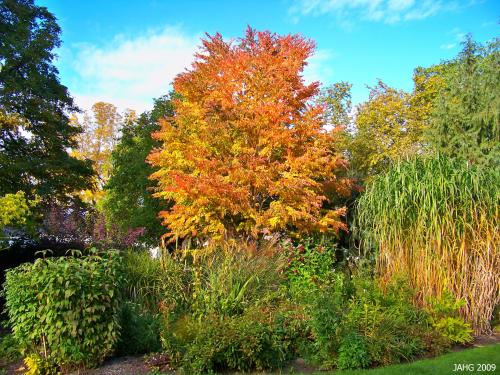When I was in Horticulture school we learned many plants ranging from small ground covers, larger shrubs and finally to the majestic trees. Some of these plants are very overused while others are not seen enough, it all depends on how well known and in fashion they are. One tree I learned is much more common in Vancouver than it is in Victoria and that truly is a pity. What I am referring to is the ‘Katsura’ tree (Cercidiphyllum japonicum) which has many features that it should be on most peoples lists of ‘must have’ trees.

Cercidiphyllum japonicum or 'Katsura Trees' on a rainy spring day in Vancouver.
At one time, long ago, Cercidiphyllum japonicum grew wild in a much larger area. Fossil records show Katsura trees lived in Europe and western North America during the Miocene Epoch 5 to 23 million years ago. Now They are found only in Japan and China. They are found in south central China, particularly in north west Szechwan province where E.H. Wilson found forests of them in 1907. The trees found in China were considered to be a variety Cercidiphyllum japonicum var. sinense at one time and were said to be more tree-like. In Japan they are found at valley bottoms where the soil is richer and there is more rainfall which these trees need.

The attractively shaped leaves is one of the most appealing aspects of 'Katsura' trees
Cercidiphyllum japonicum was introduced into cultivation in a most unusual way. Thomas Hogg Jr(1819-1892) who owned a plant nursery with his brother James. He was appointed a U.S. Marshal by President Abraham Lincoln in 1862 and was then assigned to a diplomatic mission to Japan. While he was there, Thomas sent seeds of Cercidiphyllum japonicum to his brother in 1865. His brther germinated them. Thomas was in Japan 10 years and also introduced several other well known plants; Hosta ‘Thomas Hogg’ now called H. undulata var. albomarginata is probably the most famous.

Typical fall color of Cericidiphyllum japonicum found in the perennial border at Playfair park in Saanich.
Katsura trees tend to be multi trunked specimens which have strongly ascending branches. The leaves are relatively small and delicate compared to what the trunk and branches can become when these trees become more massive with age. It is intersting to note that these trees are also somewhat unusual in that they are dioecious meaning they are male or female plants.

A massive trunk of a Cercidiphyllum japonicum found in Beaconhill Park in Victoria.
In an ideal world Katsura trees grow to be enormous, Wilson found forests of trees with trunks of 2(6cm) and 3ft(90cm) widths and had regrown from their original stumps after the original trees had been harvest. The largest one he noted was a remnant of a 17.5ft(5.33m) wide stump base. In the wild these trees can attain a height of 100ft(30m), but about half this in garden settings. These trees are the most important source of wood in Japan, and is used extensively for cabinetry and paneling there.

The color range of Cercidiphyllum japonicum ranges from crystal clear yellows through oranges and crimsons into plums as seen here.
As autumn approaches Katsura trees put on a display for the senses, visually they are stunning with a color range few trees can achieve. On any day you will feast your eyes on shades of clear yellow, butter, many shades of peach and apricot, and into more striking crimsons and plums. You will notice they give of a pleasant odor as the leaves turn color, some describe it as ‘honey like’ and others say it has more of a’caramel’ or ‘brown sugar’ quality. How ever you explain it, it is a pleasant surprise which many people look forward to every year.

The striking golden tones of a happy Katsura tree changing color in the fall.
Cercidiphyllum japonicum is almost a perfect tree. It is very pest free and adaptive to most locations. In a garden setting it will grow to about 50ft(15m) tall which will fit in nicely to many landscapes. It makes an excellent multi stemmed residential, commercial, golf course or park tree. One thing you must keep in mind when placing it is having an adequate supply of water during the dry months. Plant them in deep, rich, well drained soil. They need full sun to look their best. This tree tolerates temperature down to 20f(29c). Newly emerging leaves can be damaged by late frosts. there are several forms now on the market worth looking into if you are interested. the weeping forms are very attractive in the right location.

The same Cercidiphyllum japonicum tree in summer and fall. The corner planting along Quadra and Fairfield in Victoria.
More on Cercidiphyllum japonicum:
Excellent summation of Katsura trees: http://www.arhomeandgarden.org/plantoftheweek/articles/katsura_tree_11-2-07.htm
A very complete listing of important plant people, scroll down to Hogg: http://www.plantsgalore.com/people/plant-people-H.htm
Wiki’s listing of the famous Katsura tree and relatives: http://en.wikipedia.org/wiki/Cercidiphyllum
 Stumble It!
Stumble It!






